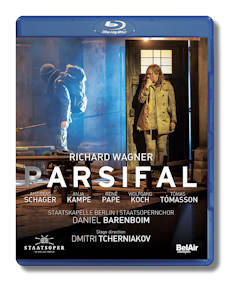
The Internet's Premier Classical Music Source
Related Links
- Wagner Reviews
- Latest Reviews
- More Reviews
-
By Composer
-
Collections
DVD & Blu-ray
Books
Concert Reviews
Articles/Interviews
Software
Audio
Search Amazon
Recommended Links
Site News
 Blu-ray Review
Blu-ray Review
Richard Wagner

Parsifal
- Amfortas - Wolfgang Koch
- Gurnemanz - René Pape
- Parsifal - Andreas Schager
- Klingsor - Tómas Tómasson
- Kundry - Anja Kampe
- Titurel - Matthias Hölle
Staatsopernchor Konzertchor Der Staatsoper
Staatskapelle Berlin/Daniel Barenboim
Stage Direction: Dmitri Tcherniakov
Costume Design: Elena Zaytseva
Set Design: Dmitri Tcherniakov
Light Design: Gleb Filshtinsky
Chorus Master: Martin Wright
Dramaturgy: Jens Schroth
HD recording: Staatsoper im Schiller Theater, Berlin - 04/2015
Bel Air Classiques Blu-ray BAC428 252m
Also available on DVD BAC128: Amazon - UK - Germany - Canada - France - Japan
For many of us Daniel Barenboim is the finest living Wagner conductor. Some might demur from quite such a sweeping judgment, but few would deny that he is one of a tiny handful of dominant interpreters of Wagner. This Parsifal, recorded live at the Berlin Staatsoper in April 2015, further cements his standing and reputation. Musically it is simply outstanding. Visually and conceptually it falls a little short of outstanding, but it is never less than thought-provoking. The combination is not quite one for the ages, as is his celebrated Ring with Harry Kupfer from Bayreuth in 1991-2, but it is definitely one of the most satisfying Parsifals that I have come across for a while.
Dmitri Tcherniakov represents the home of the Knights of the Grail as what looks like a cavernous factory interior. Steering away from explicitly modernist productions, though, this factory has colonnades. Its inhabitants are dressed in generic mid-twentieth century costumes. Think Warsaw Uprising, postwar Germany, or a Solzhenitsyn gulag – dark colors and wintry, vaguely military outfits. In Act 1, Parsifal stands out with brightly colored T-shirts that he occasionally changes on stage, pulling a new one out of the rucksack that accompanies him throughout. There is much more color in Klingsor's palace in Act 2, which Tcherniakov presents as a schoolroom painted in institutional blue, with the Flower Maidens wearing school uniforms, supervised by a benign-looking and bespectacled Klingsor, looking rather like a Latin teacher approaching retirement.
I found the staging in Act 2 somewhat disconcerting – casting children holding dolls as temptresses certainly has the power to shock. But the scene where Parsifal is beset by the (underage) Flower Maidens is suitably de-sexualized, and Tcherniakov certainly offers a new take on this scene, helped by some very fine singing from the chorus. When Kundry arrives on the scene she certainly has no difficulty projecting herself as the only adult in the room. The only part of Act 2 that fell flat for me was the final confrontation with Klingsor, where the sense of drama emerging from the orchestra pit was not matched by events on stage.
The two most striking feature of this production are definite additions to Wagner's narrative. In Act 1 the celebration of the Knights' sacred ritual takes a definitely cannabilistic turn, with the Knights draining the blood from Amfortas's wound and passing it around in a chalice. And in the final moments of the drama, Gurnemanz's increasing antipathy to Kundry culminates in his stabbing her (in the back!) while she is locked in a passionate embrace with Amfortas, turning Wagner's ideas about Kundry's redemption on their head (or alternatively, taking them to their logical conclusion). I was not particularly moved by either innovation, although both certainly succeed in highlighting the moral bankruptcy of the Knights of the Grail, who do come across as an even more unpleasant bunch than usual.
The real strengths of this production are in the conducting and singing. Barenboim sets the tone with a masterful and magisterial prelude. His pacing maintains momentum and drama through the long discursive sections of Act 1, building up to a spectacular denouement with the massed ranks of the chorus. Parsifal is hard to pace because it is relatively static, Barenboim's feel for the pulse of the music, and his ability to drive the action on the stage from the pit while maintaining balance between voices and instruments, is evident throughout.
There are no weak points among the principals. René Pape is a fine Gurnemanz, who rises to his set-pieces ("Titurel, der fromme held", for example) but is a commanding presence throughout. Wolfgang Koch offers us a suitably tortured Amfortas in the opening and closing acts, conveying both the character's pathos and his weakness. Tómas Tómason's Klingsor suffers from the sensible sweater he is forced to wear, but sounds suitably menacing at the end of Act 2. Parsifal and Kundry are both first-rate. Andreas Schager's Parsifal develops from a spoiled adolescent in Act 1 to a compelling leader in Act, singing with power, control, and delicacy throughout – a rare combination in contemporary Wagner tenors. Anja Kampe is a very fine Kundry, whose singing and acting encompasses the multiple personae of this complex role – from servile handmaiden to passionate seductress, to candidate for final redemption.
My only misgivings with this production are the woefully inadequate liner materials (no more than a sketchy act-by-act summary), and my perennial bugbear of the credits rolling during the prelude. But sound and visual quality are both excellent, with two-channel and multi-channel options available. So I recommend this Blu-ray very highly indeed.
Copyright © 2016, José Luis Bermúdez


















